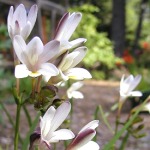
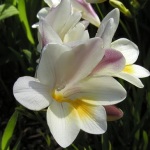
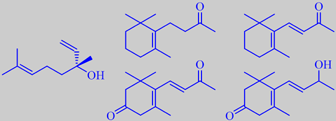
(-)-linalool, beta-ionone and -derivates from live freesias
Freesia refracta (Iridaceae)
The genus Freesia originates in southern Africa. Some botanists believe it consists of nearly twenty species, other botanists consider them all to be varieties of just one species, F. refracta. The wild type has white or yellow funnel-shaped flowers, but a multitude of sorts have been developed by cultivating. Freesia is renowned for its powerful and diffusive scent, which, however, is less appreciated by some people. Picked flowers in a vase make themselves conspicuous even in a large room.
Mookherjee et al. have demonstrated that the headspace of living and picked flowers of freesia differs considerably. Linalool represents 80-90 % in both, but dihydro-beta-ionone, beta-ionone and its derivatives 4-oxo-beta-ionone and 4-oxo-beta-ionol present in the live flowers are almost absent in the picked flowers. On the other hand, pyrazines were only detected from the picked flowers [8]. Linalool in freesia is exclusively the R-(-)-enantiomer, which has an olfactory detection threshold about ten times lower than the S-(+)-enantiomer [4].
Etymology: Freesia, after the German physician Friedrich Heinrich Theodor Freese (1795–1876).
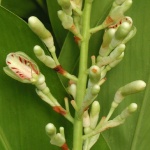
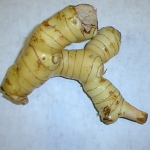
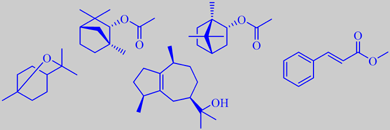
fenchyl- and bornyl acetate, 1,8-cineole, guaiol, and methyl (E)-cinnamate
Alpinia galanga (Zingiberaceae) Galanga major, Laos root, Siamese ginger, Khaa
This is another popular culinary and medicinal plant of the ginger family. The fresh galanga rootstock (rhizome) is typical for the cuisine of Thailand. For example it is used finely sliced in soups of the tom yam type. The ginger-like rhizome is built up from cylindrical subunits marked by characteristic rings. Its flavour is completely different from that of ginger. The fresh rhizome has a piney flavour due to fenchyl acetate and bornyl acetate. Its other major volatiles are 1,8-cineole, guaiol and methyl cinnamate. The 'sharp' constituents, causing the burning sensation on the mucous membranes, partly consists of phenylalkanones like those in ginger [24].
(The Galanga minor, Kaempferia galanga, is mostly used in Malaysia and Indonesia. Its aroma is less pleasant, stronger, more aromatic and 'medicinal')
Etymology: Lat. Alpinia, in memory of the Italian botanist Prospero Alpino (1533–1617); Lat. galanga, from Arabic khalangian, from Chinese liang-kiang, mild ginger.